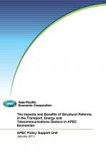 Autores: Pedro Cantos, José Manuel Pastor y Lorenzo Serrano
Autores: Pedro Cantos, José Manuel Pastor y Lorenzo SerranoTítulo: Quantifying the benefits from structural reforms in railway transport markets in APEC Economies
Fuente: The impacts and benefits of structural reforms in transport, energy and telecommunications sectors
Resumen: The authors have estimated productivity change indicators for a sample of 34 railway systems during the period from 2001 to 2008. These indexes have been decomposed in efficiency changes and technical change. The methodology used to estimate these indexes has been the DEA approach. The results show that, on average, the productivity, efficiency and technical changes are slightly lower for the APEC rail systems. In particular, the average rate of productivity change for APEC rail systems rose by 3.5% per year, while for non-APEC economies productivity rose by 4.8%. The Russian Federation; Viet Nam; and China showed the highest rates, while Chinese Taipei and Korea had the lowest. However, China; Japan; and the USA were efficient during the whole period. In any case, we observe again that, on average and excepting Viet Nam, APEC rail systems did not improve their efficiency scores, while non-APEC economies did improve their efficiency scores by 1.4% per year. Finally, APEC member economies improved, on average, their rate of technical change by 3.2%, while non-APEC economies improved by 3.7%.
Cómo citar este documento:
Cantos, P., J.M. Pastor y L. Serrano, 2011. "Quantifying the benefits from structural reforms in railway transport markets in APEC Economies", en Findlay, C. ed.: The impacts and benefits of structural reforms in transport, energy and telecommunications sectors. Singapur: Asia-Pacific Economic Cooperation, capítulo 5, pp. 103-123.
Otros artículos:
Más artículos






